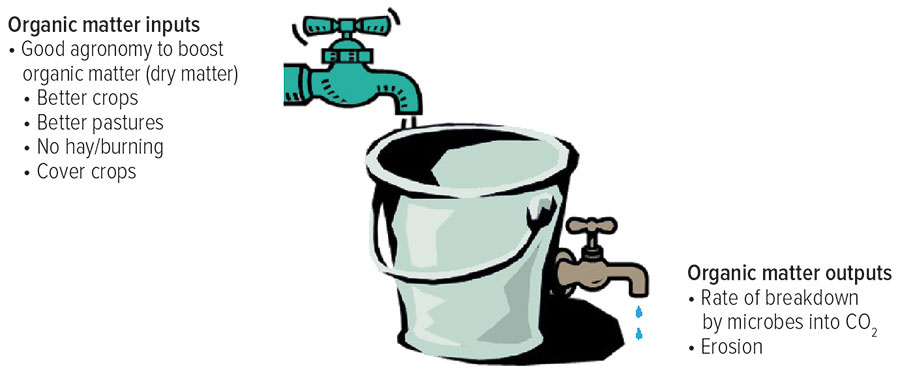The best practices for productivity and profitability are essential to protect and rebuild soil organic matter, including organic carbon and nitrogen supplies.
Key points
- Land clearing leads to sharp declines in soil organic matter and organic carbon
- Fallowing is the biggest cause of organic matter declines in cropping soils
- Growing highly productive crops and pastures is essential in arresting the decline
Soil organic matter is critical for healthy soils and sustainable agricultural production. It provides food for microbes and the microbial activity that supplies nutrients to crops, maintains soil structure and water infiltration and helps keeps pathogen populations in check. However, soil organic matter levels are declining under continuous cropping.
On well-structured soil, the biggest impact of this decline is the loss of soil nutrients, especially nitrogen. For example, annual mineralisation of nitrogen from organic matter on recently cleared brigalow soils in Queensland can be as high as 300 kilograms of nitrogen per hectare, but this could decline to about 50kg/ha after 30 years of cropping.
This drop in fertility can be managed by increased rates of fertiliser. However, management must be spot-on to match nitrogen rates to crop needs, as lower organic matter levels mean the soil is less resilient and less able to respond to seasonal changes.
Carbon decline
Soil organic matter is approximately 60 per cent organic carbon, which is an easily measured indicator of organic matter, soil health and the sustainability of long-term crop production.
GRDC investment from 2008–17 enabled the Queensland Department of Agriculture and Fisheries to work with growers to identify the effects of land-use and farming practices on soil organic carbon levels across the northern grain region.
Paired-site comparisons on 500 paddocks showed that clearing land for cultivation for 20 or more years led to a consistent decline in soil organic carbon. The main cause of this decline in cropping systems was fallowing to store moisture.
Fallow efficiencies of between 20 to 30 per cent mean that 70 to 80 per cent of fallow rainfall is lost to evaporation. It is not used by plants to produce dry matter and replenish the organic matter that continues to be decomposed by microbes in the moist soil.
Mixed farmers who grow prolonged pasture phases have much-greater potential to rebuild and manage their soil organic matter and carbon levels than grain-only farmers. However, these pasture phases must produce high levels of dry matter based on a good supply of nitrogen from fertiliser or legumes. There was little improvement in organic carbon from poor pastures that were deficient in phosphorus and lacked strong legume medic growth.
Pastures phases of at least five years were needed to generate a significant increase in organic carbon levels. Well-grown pastures could generate soil organic carbon improvements of up to one tonne per hectare per year.
Continuous cropping
Building soil organic matter within continuous cropping systems, or at least limiting the decline, requires good agronomy to grow high-yielding crops, with as much dry matter as possible, as often as possible (Figure 1).
Figure 1: Soil organic carbon levels are a balance between organic dry matter inputs, losses and decomposition.
 Source: David Lawrence, Queensland Department of Agriculture and Fisheries
Source: David Lawrence, Queensland Department of Agriculture and Fisheries
The best practices are already well-known to growers:
- use zero or reduced tillage to maximise water capture;
- grow more crops and higher-yielding crops with adequate nutrition;
- consider cover crops and companion crops if they can increase dry matter production without compromising grain yields;
- avoiding burning and baling that removes dry matter and nutrients from the paddock; and
- use pasture phases where practical.
Introducing the best profitable practices as soon as possible – rather than waiting until soils suffer major declines – is important, both in younger country and to prolong the gains after pasture phases.
More information: David Lawrence, 0429 001 759, david.lawrence@daf.qld.gov.au, GRDC Update paper: How soil organic matter and carbon work! Data from 500 paired-site comparisons across the northern region

























































